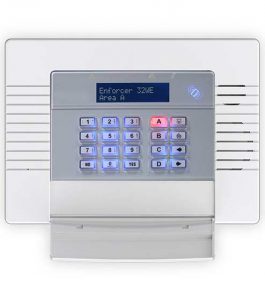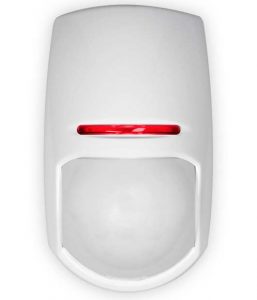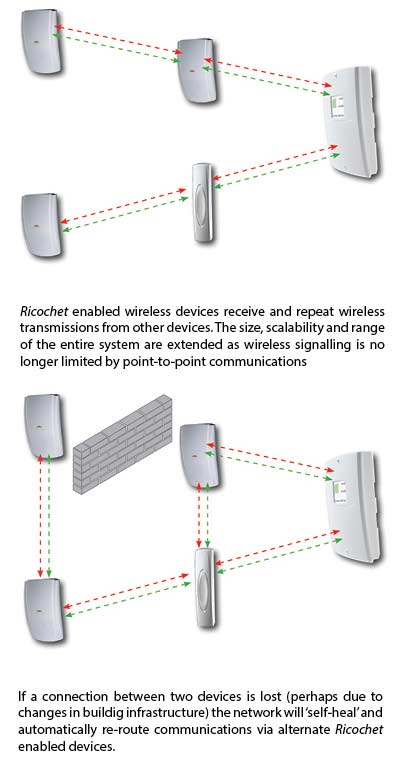INTRUDER ALARMS
Wired and Radio Intruder Alarm Systems
A good Intruder Alarm System is probably the most important part of property protection.
“Bell Boxes” (which are actually electronic sirens with a strobe light) are the first line of defence and should be mounted in a prominent position on the property where it is visible from the main approach. One or more of these (or dummy Bellboxes) may be used on other approaches. These are the visible indication of an alarmed property and act as a deterrent.

A variety of different detectors are used inside the property to detect someone opening or breaking through a door or window, or the presence of a person within a room.
Door and window contacts may be used which incorporate a small magnet and a metal switch which is triggered when the door or window opens, separating the magnet from the switch.
Most systems will incorporate PIRs (Passive Infra Red detectors) that will detect a moving warm object (a person) in a room and set off an alarm.
Simple PIRs are very effective but may react to warm air currents or small animals. In this case more sophisticated detectors such as a “Quad” which is basically 2 Infra Red sensors detectors in the same unit or a “Dual-Tech” which incorporates Infra Red and Microwave (2 different technology) sensors in the same unit. In areas where there are significant sources of false alarms there is even a “Tri-Tech” which also adds a pressure sensor to give the highest level of immunity to false alarms.

Other intruder detectors include shock sensors which can be placed on window and door frames and acoustic “glassbreak” sensors that react to the frequency of the sound of glass being smashed. Other accessories are available to add to systems such as smoke, carbon monoxide and flood detectors.
Many systems now have built in communicators for sending SMS text or voice messages to mobile phones and phone apps.
Hold Up (Panic) Alarms
Panic Alarm devices can be added if people need to set off the alarm manually when the system is not armed. These would often be included in systems used by vulnerable people or in commercial environments, eg a jewellery shop.
System Monitoring
Systems can be set up so that intruder alarms and panic alarms are monitored for emergency police response. In this case the property needs to be registered with the local Police Force who will issue a URN (Unique Reference Number) for the property. They charge a small fee for this and separate URNs are required for Intruder and Panic Alarms.

Radio or Wired Intruder Alarms?
Radio Intruder Alarm Systems are now about the same price as a wired system and are the system of choice in completed properties unless the floorboards are being lifted or you don’t mind seeing cables run along the walls.
Apart from the Control Panel the detectors are battery powered. The systems we supply use batteries that are available over the counter or online and have a life expectancy of 3-4 years. They can be changed by the user but as part of our Servicing & Maintenance package we offer to change the detector batteries every 2 years for a nominal fee.
Radio System Advantages
- No disruption to existing decoration
- No chance of cables to devices being broken
- Devices are fixed with a couple of screws and can easily be moved if rooms are rearranged
- Radio Key Fobs can be used to set and unset the system from inside or immediately outside the house which avoids the rush to the keypad to put in the code
- Installation takes a fraction of the time required for a wired system (hence the price similarity)
- Radio detectors can be installed in outbuildings that may not be attached to the main property

There are limitations to the range of the radio signals, but the Texecom Ricochet systems use PIRs, Door Contacts, Keypads, Bellboxes etc that each act as a repeater, creating a radio “mesh” that bounces signals from device to device to cover large distances.
Radio System Disadvantages
- Batteries do need to be changed every 2-3 years
- Radio signals do not penetrate every boundary (we would do a radio test first)
- An intruder alarm system using radio devices can only be Grade 2 (see System Grades)
Intruder Alarm System Grades
While we will conduct a risk assessment to determine which “grade” of intruder alarm system is required based on the probability and impact of a theft, your insurer may specify the grade that they require in order for their insurance to be valid. They may also indicate the grade of monitoring, if police response is required.
BS EN 50131-1 is the standard that gives an overview of which type of premises would typically require different grades of Intruder Alarm systems and some guidelines are below:
Grade 1 – Low Risk
Where an intruder is likely to be “opportunist” and have a limited tools with which to enter the premises. This may be suitable for a small domestic property where there is little of known interest.
Grade 2 – Low to Medium Risk
This is the most common grade and would be applicable to most domestic and low risk commercial properties where intruders may have some knowledge of intruder alarm systems and may have the tools to be able to quickly gain entry.
Grade 3 – Medium to High Risk
This applies to properties that typically would have target goods that are highly desirable to an intruder and may be easily removed, with high values of items such as specialist tools, jewellery, cigarettes, etc. An intruder would have a good knowledge of alarm systems and police response times and may have tools to overcome radio-based detection devices.
Grade 4 – High Risk
High risk properties include Banks, Government Buildings and other businesses where an intrusion would be a serious breach in their security and affect their business continuity and public liability.

For a free Risk Assessment and System Design Proposal, contact us now on 01249 783361.
